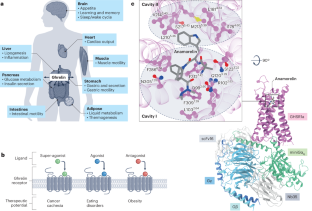通过生长素受体治疗癌症恶病质的个性化药物
IF 12.5
1区 生物学
Q1 BIOCHEMISTRY & MOLECULAR BIOLOGY
引用次数: 0
摘要
ghrelin受体(GHSR1a)是治疗癌症恶病质的关键靶点。现在一项研究揭示了与获批药物anamorelin结合的GHSR1a-miniGq复合物的结构,为超激动作用在癌症恶病质治疗中的作用提供了新的见解。这项综合研究为个性化治疗策略提供了框架。本文章由计算机程序翻译,如有差异,请以英文原文为准。


Personalized medicine for cancer cachexia via the ghrelin receptor
The ghrelin receptor (GHSR1a) is a key target for treating cancer cachexia. A study now reveals the structure of the GHSR1a–miniGq complex bound to the approved drug anamorelin, providing insights into the role of superagonism in cancer cachexia therapy. The comprehensive study represents a framework for personalized treatment strategies.
求助全文
通过发布文献求助,成功后即可免费获取论文全文。
去求助
来源期刊

Nature Structural & Molecular Biology
BIOCHEMISTRY & MOLECULAR BIOLOGY-BIOPHYSICS
CiteScore
22.00
自引率
1.80%
发文量
160
审稿时长
3-8 weeks
期刊介绍:
Nature Structural & Molecular Biology is a comprehensive platform that combines structural and molecular research. Our journal focuses on exploring the functional and mechanistic aspects of biological processes, emphasizing how molecular components collaborate to achieve a particular function. While structural data can shed light on these insights, our publication does not require them as a prerequisite.
 求助内容:
求助内容: 应助结果提醒方式:
应助结果提醒方式:


